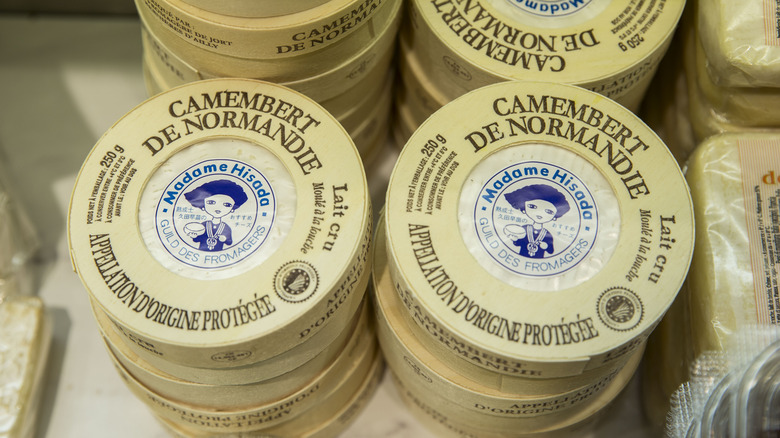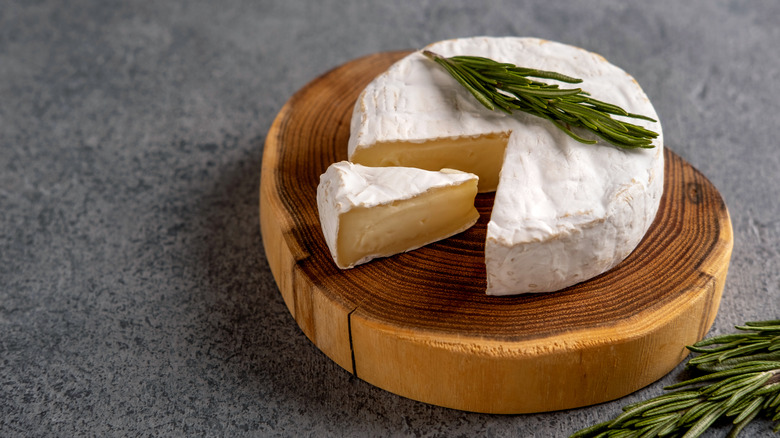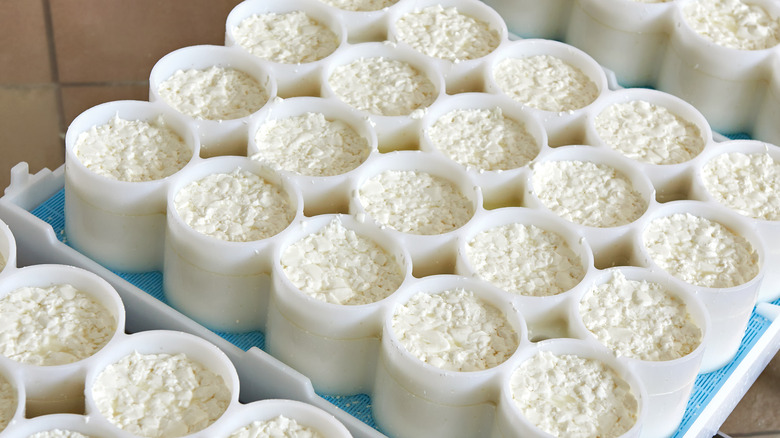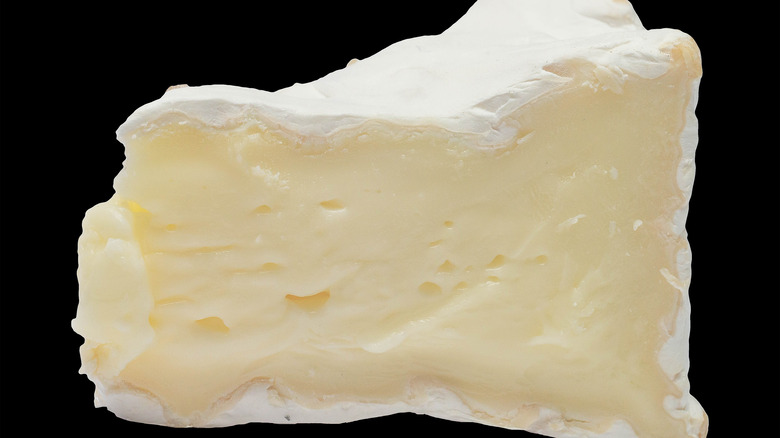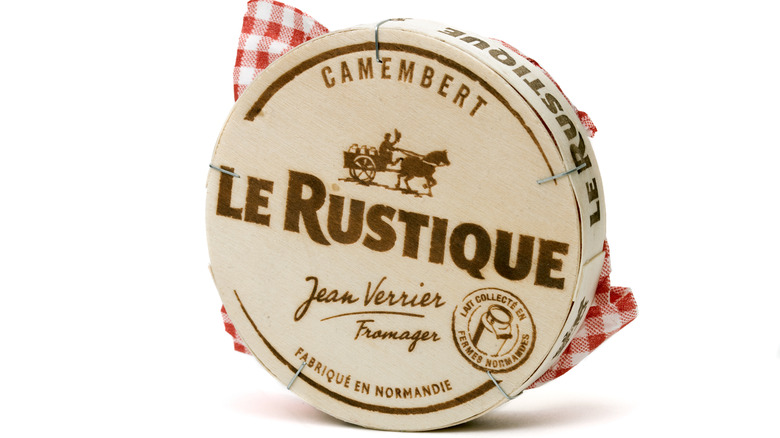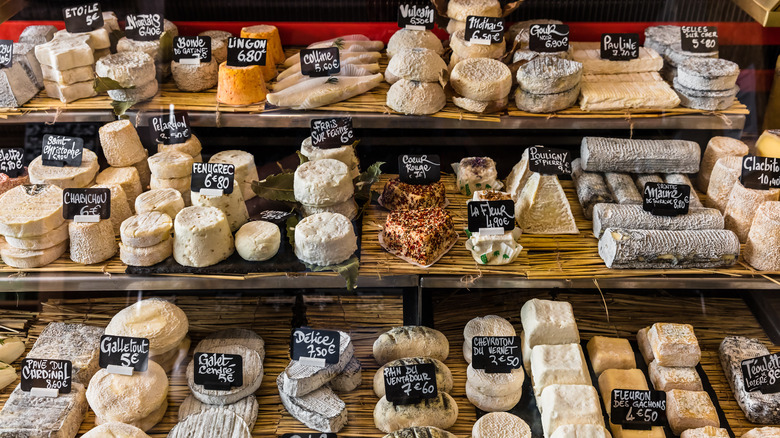What Is Camembert Cheese And What Does It Taste Like?
Shall I compare thee to a French cheese? Perhaps that's what famed composer Cole Porter thought when he decided to name drop Camembert in his show tune classic "You're The Top," a duet in which two lovers compliment each other through comparisons to the most incredible things in life (via Genius). You're not just any cheese. You're Camembert.
It may seem odd to think of being compared to a cheese as romantic. But, with Camembert, that's not out of the question. It's one of the most popular and coveted cheeses in human history, with the likes of historic figures including Napoleon and Salvador Dali, and modern food celebrities like Antoni Porowski and Ina Garten claiming to be huge fans. In fact, 65,000 tons of it are sold in France every year (via New York Times). But what exactly is Camembert cheese, and what makes it so special?
Named for the idyllic countryside town in Normandy, France where it originated back in the 18th century, Camembert is a soft-ripened cow's milk cheese with an ivory-colored exterior and creamy, buttery center. Like its close sister, Brie cheese, it has a strong flavor thanks to its edible, bloomy rind that's treated with a specific type of mold during the aging process (via Culture Cheese Mag).
But where Camembert differs from its relative is that it has a much more pungent, earthy taste, containing notes of truffles and even cabbage thanks to the type of grass the Normandy cows consume, says Whole Foods. Its distinct aroma and flavor combination has been capturing the noses and palettes of people for centuries — and to this day, many consider it to be one of France's most iconic cheeses (via Taste Atlas). Even McDonald's once sold burgers containing Camembert (via Eater).
Camembert may have been invented by accident
Though some scholars view the story of Camembert's creation as a mere folk tale rather than encyclopedic fact, it's widely believed that it originated on a dairy farm in the Normandy region of France during the French revolution (via Normandy Tourism). The story goes that in 1791, right at the peak of the revolution, a priest from the town Brie (yes, the hometown of that Brie) was looking for a place to hide out in the Camembert village, to be safe from violent revolutionaries, when he came across Marie Harel. She was the wife of a dairy farmer who took him in, and in exchange for her hospitality, the priest taught her how to make Brie.
However, it seems Marie missed a step or incorrectly followed the instructions, because what she ended up making was something much more pungent and colorful, aka the first-ever Camembert. After discovering that her accidental cheese was actually as delicious as the Brie, the recipe was shared throughout the Normandy valley and became quite popular among the locals.
It wasn't until nearly a century later, when an engineer called Ridel invented a wood box to transport the cheese, that people all over the country were able to get a taste of the yummy new creation (via Taste Camembert). Several decades later, it became a staple food for French soldiers fighting in World War I, which cemented its status among the public as more than just a food, but a symbol of French history (via Culture Cheese Mag).
How Camembert gets made today
At its most basic level, Camembert is like most other soft-ripened cheeses, which basically means that mold has been added to it during the production process to give it a thin "blooming" white rind that ripens the cheese from the outside (via The Spruce Eats), and thus giving it its signature silky smooth texture.
But, if you're curious about the full process, it goes like this: After the milk is collected, it's left to sit for a day so that it forms the optimal environment for microorganisms. As Food Insider explains in this YouTube video, it takes two liters of milk to make a single disc of Camembert. After the initial sitting period, rennet, a specific type of milk protein, is added to the milk to spur the curdling process. Next, the curds are cut vertically and hand-ladled into cylinder molds, five times over 50-minute increments. The belief here is that carefully scooping the curds, rather than dumping them in all at once, lends to a smoother texture in the finished product (via Fromagerie Graindordge). Once the scoops are in, the cheese drains for a minimum of 18 hours, and is then sprayed with Penicillium Camemberti, a special type of mold that forms the white rind and ripens the cheese.
Finally, the cheeses are sent to a maturing room for a minimum of four weeks, where each disc is turned several times to ensure the moisture is distributed evenly on the inside (via The Spruce Eats). It becomes ready to consume once it develops a supple, ivory-colored rind and strong, earthy scent.
There's a lot of controversy about what constitutes real Camembert
Although most of the Camembert you'll find in today's markets is made with pasteurized milk, cheese purists will be quick to remind that authentic French Camembert is made exclusively with raw milk from Normandy cows (via New York Times). Now, if you're wondering as to whether that really matters, it depends. According to The Outline, some culinary experts claim cheeses made with unpasteurized milk tend to have a more complex flavor because they contain unique bacteria that generally goes away with pasteurization. However, many people find there are still plenty of Camemberts that taste just as good that aren't made the old-fashioned way.
But, if your heart is set on getting the real deal, know that it isn't as easy as you'd think — even in France. The French laws aren't very strict when it comes to naming, and consequently, many cheese producers get by selling versions of Camembert cheese under fancy names that sound like the real deal (via Paris Personal Tours). For instance, you may come across something labeled "Camembert fabrique en Normandie", which translates to "Camembert made in Normandy." But this isn't the same as "Camembert de Normandie," the OG stuff. The former designation just means that some of the milk has to come from Normandy, but the rest can be a mix of milk from wherever. To use the latter name, however, the cheese needs to be made exclusively with raw, unpasteurized milk from those special Normandy cows. Kind of like the distinction for true Champagne.
To make matters even more complicated, the New York Times reported in 2018 that France was planning to change the law to allow all French-made Camembert, even those that don't contain the requisite raw milk from Normandy cows, the freedom to use the label that designates them as a true product. This naturally upset a lot of smaller Camembert producers and has since resulted in numerous petitions and protests.
How to tell if you're eating real Camembert
Should you ever find yourself in a French market questioning whether you're looking at a true Camembert by the official definition, there are some things to consider. Number one is a label that reads "P.D.O." that stands for "protected denomination of origin." This means that this cheese has met all the legal production and ingredient requirements to be deemed an official Camembert (via Mental Floss). In this case, those requirements are that the cheese must weigh 250 grams, be 10 centimeters in diameter, and made with unfiltered, raw milk from at least 50% Normandy cows (via New York Times).
However, don't feel too discouraged if you have trouble coming across the real thing. According to Mental Floss, only 1% of the 360 million wheels of Camembert that are made every year actually meet these requirements, meaning most of what's out there isn't really authentic. But again, that doesn't mean it isn't any less delicious.
Where to purchase Camembert
Unfortunately, the sale of cheese that is made with unpasteurized milk carries the risk for food-borne illness, which means that the sale of authentic French "Camembert de Normandie" is illegal in the US as it violates FDA standards.
However, this doesn't mean you're totally out of luck when it comes to tasting this iconic cheese Stateside. There are plenty of Camemberts that are manufactured in the US that are widely available in markets all over the world — thanks to scientists that figured out how to replicate the Penicillium Camemberti mold (via WGBH). Today, you can enter most specialty stores and supermarkets and find Camembert from California, Vermont, or even the UK.
If quality is a concern, BBC Good Food provides tips on how to distinguish more refined cheeses. They say that cheaper Camembert varieties will come in cardboard packaging, while artisanal ones will come in the traditional wood box and probably cost more. Additionally, they point out that a good Camembert will have a white, slightly bumpy rind with some colorful reddish and orange spots. But, be sure to watch out for any holes or cracks in the rind, along with slimy brown spots — that means the cheese is possibly overripe and spoiled (via Whole Foods ).
How to best enjoy Camembert cheese
One of the most popular ways to enjoy soft-ripened cheeses like Camembert is by baking them, which turns these discs into yummy, gooey cheeses that are perfect for dipping. When doing this, be sure you slice the top rind, otherwise the cheese will remain intact and dry. For the best results, you'll want to bake at 350 degrees Fahrenheit for 15 to 20 minutes tops. Any longer and you may ruin the texture (via Not Just Jugs).
But, whether your preference is for baking cheese or eating it straight off a platter, it seems across the board that most experts recommend you don't eat Camembert chilled. It's not going to hurt you if you do, of course, but if you want to enjoy the cheese at its optimal flavor, let it set on the counter for at least an hour before diving in so it comes to room temperature (via Youtube/Epicurious). When ready to serve, Epicurious suggests cutting it like a pie, which allows for every piece to get a little bit of the soft, buttery center and flavor-packed rind.
And, if you decide you only want to eat a nibble at a time, that's fine, too. Per The Spruce Eats, you can store leftover Camembert in the fridge for up to two weeks after opening the package. Just be sure to wrap it wax paper and loose plastic wrap to preserve its flavor and quality as best as you can. NPR also notes that the cheese is best consumed within three days of opening, but if you can't get to it then, baking may be a good option for serving it.
